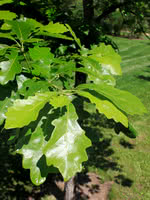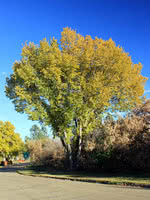Mon-Fri 9am - 5pm Mountain time
Bur Oak vs American Elm
Quercus macrocarpa
Ulmus americana
Bur Oak has a wide distribution but is one of the only oaks that will grow well on the prairies. Bur Oak produces deeply lobed, dark green leaves that turn golden yellow to brown in the fall.
Its acorns are round and half enclosed by a mossy fringed cup.
Although slower growing, this long lived tree eventually becomes a popular large ornamental tree for driveways, parks, and the front of industrial buildings. Popular as a memorial or dedication tree.
Note: Most Oak species can be considered toxic for many animals.
American Elm is fast growing, tall tree with a recognizable and pleasing shape.
It's well suited for urban environments because of its non-invasive roots and ability to grow on harsh sites (quite salt tolerant). American Elm develops a wide, dense canopy that provides shade for many city streets around North America.

